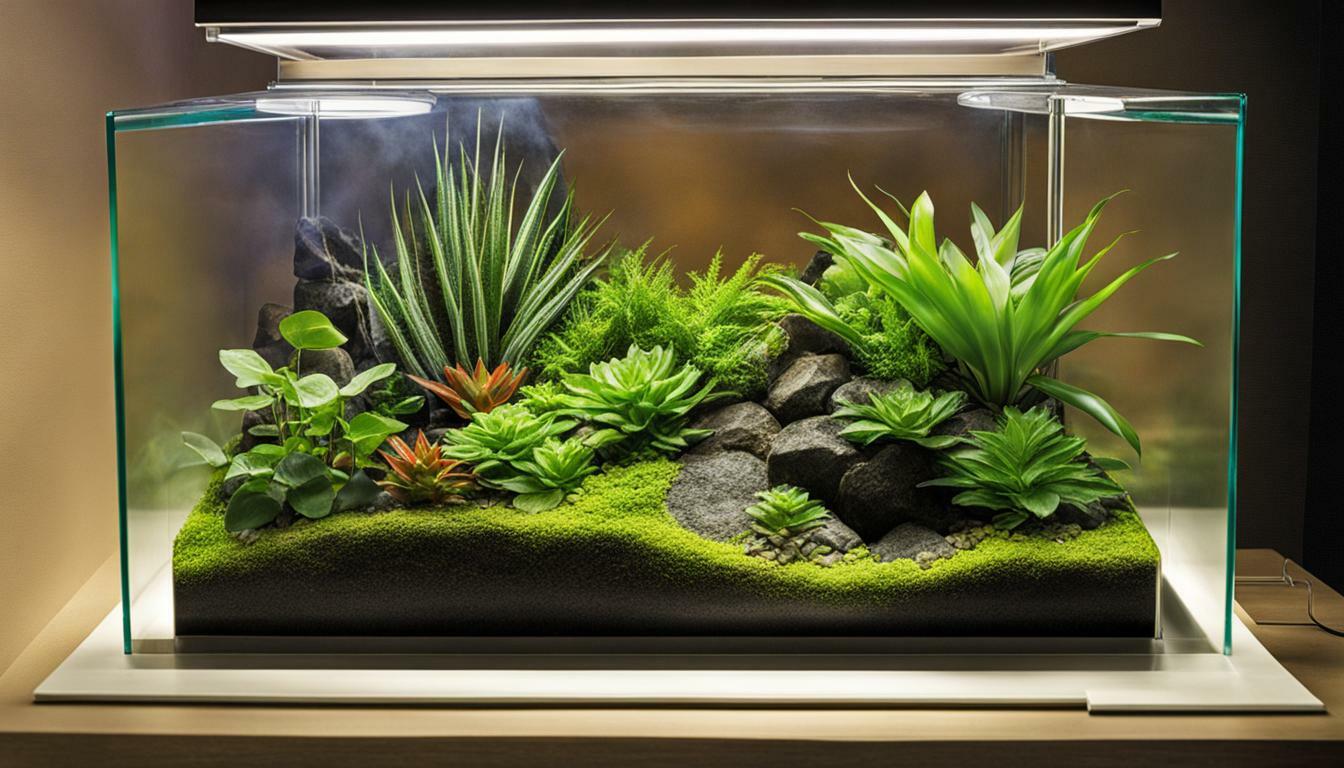Terrarium care requires attention to ventilation solutions to ensure optimal health for your plants. Proper air circulation is essential to maintain a healthy terrarium environment. Inadequate ventilation can lead to issues like mold, high temperatures, and stagnant air, which can negatively impact your terrarium’s well-being. In this guide, we will explore the importance of ventilation in terrarium care and provide effective solutions to keep your plants thriving.
Key Takeaways:
- Poor air circulation in a terrarium can result in stagnant air, high temperatures, and mold growth.
- Effective ventilation techniques include proper placement of vents and air holes, as well as lid ventilation.
- Mold, fungus, and bacterial infections can be prevented and treated by maintaining proper ventilation and cleanliness.
- Algal blooms can be controlled by reducing sunlight exposure and adding plants to consume excess nutrients.
- Preventing overheating in terrariums involves improving ventilation, managing plant growth, and creating shaded areas.
Taking these key takeaways into consideration will help you create an optimal terrarium environment for your plants. By mastering ventilation solutions, you can ensure the health and longevity of your terrarium ecosystem.
Understanding the Importance of Ventilation in Terrariums
Proper ventilation is essential for maintaining a thriving terrarium, as it prevents mold growth and ensures optimal temperature and air quality. Poor air circulation can be detrimental to the health of your terrarium, leading to issues such as stagnant air, high temperatures, and the growth of mold and other harmful organisms. To avoid these problems, it is important to implement effective ventilation solutions.
One of the main causes of poor air circulation in terrariums is a small or overcrowded environment. When the terrarium is tightly fitted or lacks proper ventilation, the air becomes stagnant and can hinder the plants’ growth. This can lead to an unhealthy environment, making it difficult for the plants and other organisms to thrive.
To improve air circulation, make sure to open vents and air holes in the terrarium. This will allow fresh air to enter and circulate, creating a healthier and more hospitable environment. Additionally, consider using a lid with ventilation openings to promote the flow of air throughout the terrarium.
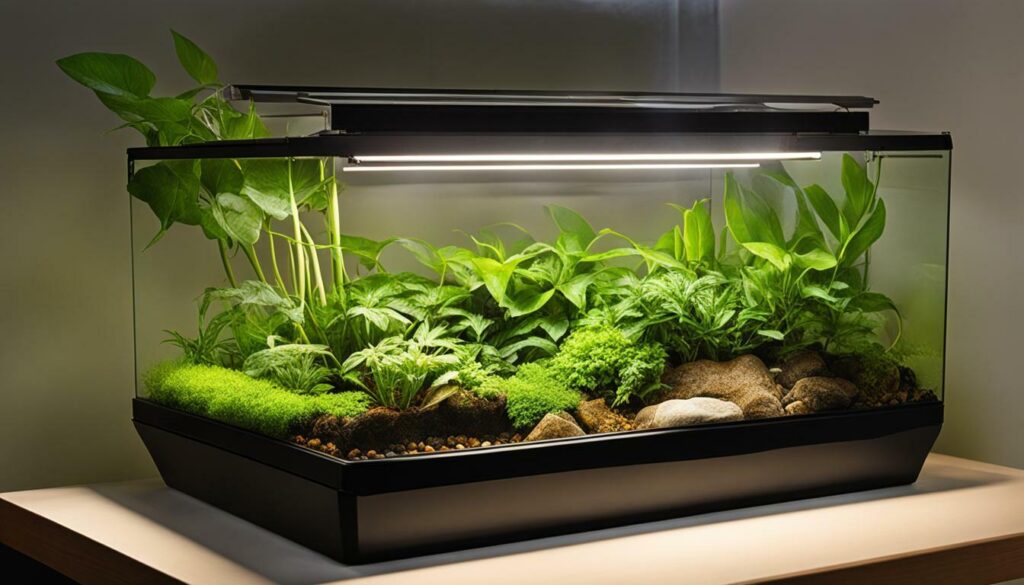
Proper ventilation also plays a crucial role in preventing mold, fungus, and bacterial infections in terrariums. These issues can arise due to uncleaned terrariums or high humidity levels. By maintaining good airflow within the terrarium, you can reduce the risk of these infections. Regularly clean and remove any decaying plant material, as they can contribute to the growth of harmful organisms.
By prioritizing ventilation in terrarium care, you can create an environment that promotes healthy plant growth and prevents the development of common terrarium issues. Proper air circulation, along with other essential factors like lighting, temperature, and humidity control, will contribute to the overall success and longevity of your terrarium.
Effective Terrarium Ventilation Techniques
To ensure proper ventilation in your terrarium, it is important to follow effective techniques that promote optimal airflow and prevent stagnant conditions. Poor air circulation can lead to issues like mold, high temperatures, and stagnant air, which can be detrimental to your terrarium’s health. By implementing the following practices, you can create the ideal environment for your plants and inhabitants:
- Open Vents and Air Holes: Ensure that all vents and air holes are open and clear. This allows fresh air to enter the terrarium and stagnant air to escape, maintaining a healthy airflow.
- Strategic Lid Ventilation: If your terrarium has a lid, it is crucial to provide ventilation. Consider using a mesh or screen material for the lid to allow for proper airflow. This will prevent the build-up of warm air and promote the exchange of fresh air.
- Clear Airflow Pathways: Keep the pathways within your terrarium clear of any obstructions. This includes removing any excess foliage or objects that may impede proper airflow. By doing so, you can ensure that air circulates freely throughout the terrarium, preventing the accumulation of stagnant air.
Remember to regularly monitor and adjust the ventilation in your terrarium based on its specific needs. Each terrarium may require different airflow conditions depending on various factors such as the number of plants, size of the terrarium, and humidity levels. By following these best practices, you can create an ideal terrarium environment with optimal ventilation.
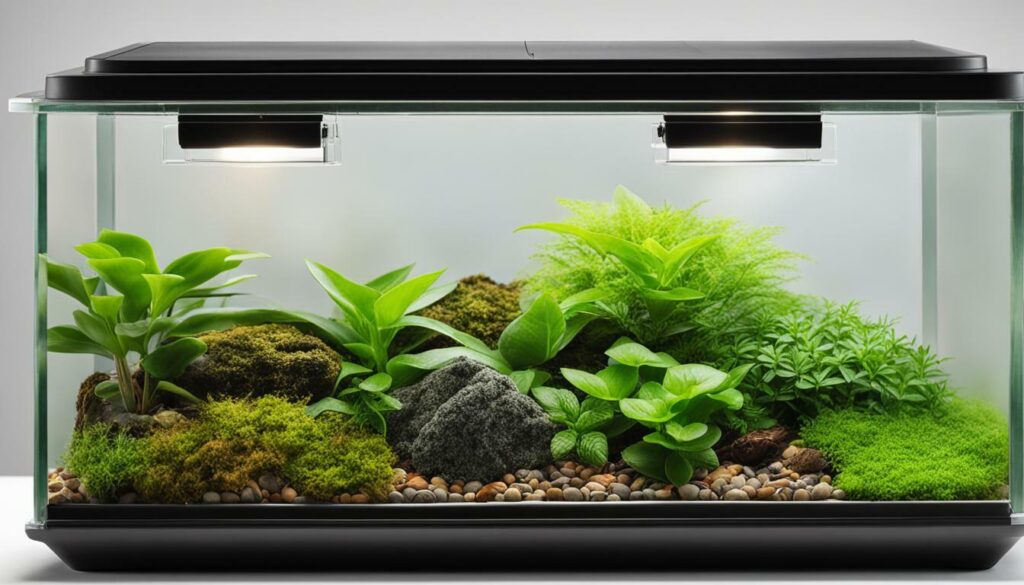
| Technique | Description |
|---|---|
| Open Vents and Air Holes | Ensure that all vents and air holes are open and clear to allow fresh air to enter and stagnant air to escape. |
| Strategic Lid Ventilation | Use a mesh or screen material for the lid to promote proper airflow and prevent the build-up of warm air. |
| Clear Airflow Pathways | Remove any obstructions within the terrarium to ensure that air circulates freely and prevents stagnant conditions. |
“Proper ventilation is essential for maintaining a healthy and thriving terrarium. Without adequate airflow, your terrarium may become prone to issues such as mold, high temperatures, and poor plant growth. By following effective ventilation techniques, you can create an environment that supports optimal airflow and prevents stagnant conditions.”
By prioritizing proper ventilation in your terrarium, you can safeguard its health and create a thriving ecosystem for your plants and inhabitants. Incorporate these ventilation techniques into your terrarium care routine and enjoy the benefits of improved air circulation and overall terrarium well-being.
Dealing with Mold, Fungus, and Bacteria Infections
Terrariums are prone to mold, fungus, and bacteria infections, but maintaining proper ventilation can significantly reduce the risk and address any existing issues. Poor air circulation, coupled with high humidity, creates the perfect environment for these infections to thrive. To prevent and treat mold, fungus, and bacteria infections, it is essential to keep the terrarium clean and ensure adequate airflow.
One effective way to combat these infections is by removing the affected areas and cleaning them thoroughly. This can be done by gently wiping the surfaces with a mild detergent solution or using hydrogen peroxide for stubborn stains. Regularly inspect the terrarium for any signs of mold, fungus, or bacterial growth, such as fuzzy patches or unusual discoloration.
Proper ventilation plays a vital role in preventing these infections. Open vents and air holes allow fresh air to circulate, reducing the buildup of moisture and creating an inhospitable environment for mold, fungus, and bacteria. Additionally, adequate ventilation helps maintain a healthy balance of temperature and humidity, further inhibiting the growth and spread of these harmful organisms.
| Preventive Measures | Treatment Methods |
|---|---|
|
|
By following these preventive measures and promptly addressing any existing issues, you can maintain a healthy and thriving terrarium. Remember to monitor the terrarium regularly and adjust the ventilation as needed to ensure the optimal environment for your plants and inhabitants.
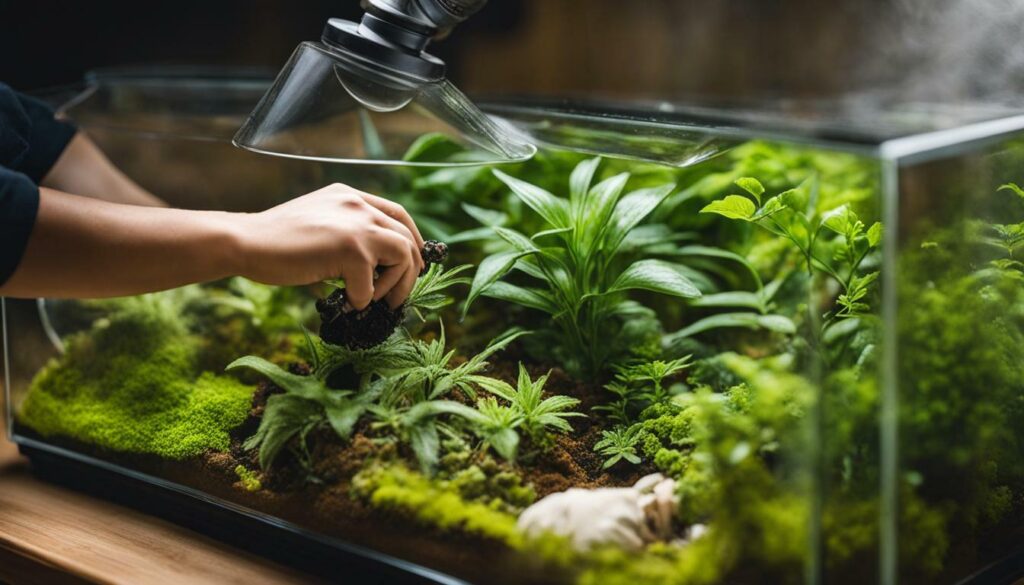
Algal blooms can be a common problem in terrariums, but with proper ventilation, you can effectively manage and prevent them from occurring. These blooms can result from excessive sunlight, warm temperatures, and an abundance of nutrients. To address this issue, it is important to reduce light exposure and remove any affected areas. Additionally, introducing plants that consume excess nutrients can help control algal growth.
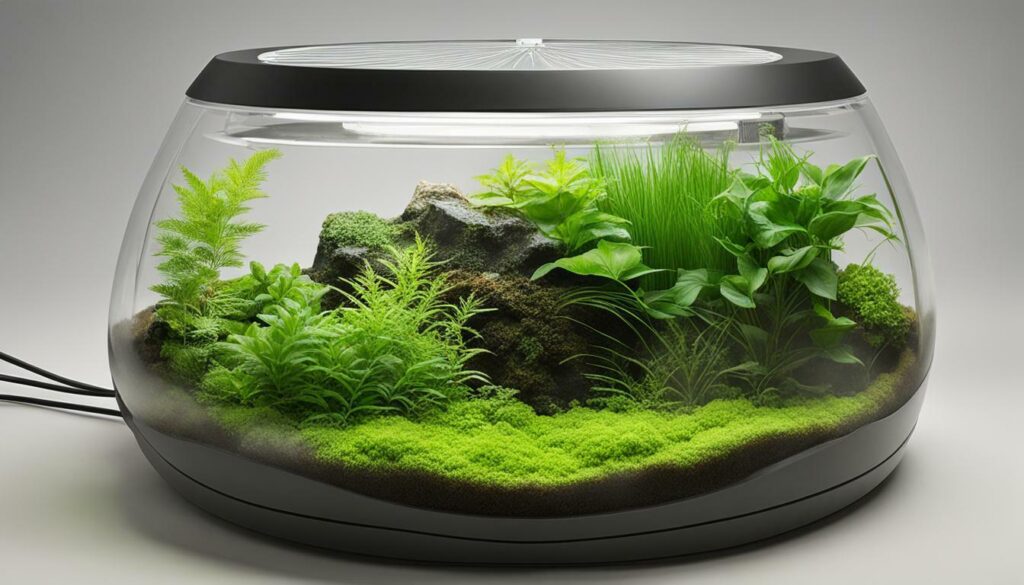
One effective method for managing algal blooms is through proper ventilation. Ensuring that there is adequate air circulation within the terrarium helps prevent the stagnant conditions that algae thrive in. This can be achieved by keeping vents and air holes open and clear. By allowing fresh air to flow through the terrarium, you create an environment that is less conducive to algal growth.
Another important aspect of managing algal blooms is maintaining a balanced terrarium ecosystem. This includes regularly cleaning the terrarium to remove any decaying organic matter, which can contribute to nutrient buildup. It is also crucial to monitor and regulate the terrarium’s humidity levels, as excessive moisture can promote algal growth. Proper ventilation plays a vital role in controlling humidity and preventing the conditions that support algal blooms.
| Tips | Description |
|---|---|
| Reduce light exposure | Place the terrarium in an area with indirect sunlight or use blinds or curtains to limit direct light exposure. |
| Remove affected areas | If algal growth is present, carefully remove the affected plants or decor to prevent further spread. |
| Add nutrient-consuming plants | Introduce aquatic plants or mosses that consume excess nutrients, helping to keep the nutrient levels balanced. |
| Maintain proper ventilation | Keep the terrarium well-ventilated by ensuring vents and air holes are unblocked and allow for adequate airflow. |
In summary, managing algal blooms in terrariums relies on proper ventilation to create a balanced environment. By reducing light exposure, removing affected areas, adding nutrient-consuming plants, and maintaining good ventilation, you can effectively control algal growth. Regular cleaning and monitoring of the terrarium’s humidity levels are also essential in preventing the conditions that promote algal blooms.
How Does Temperature Regulation Affect Terrarium Ventilation?
Proper temperature regulation essentials for terrarium care are crucial for maintaining adequate ventilation. Temperature directly affects air movement and flow within the terrarium. If the temperature is too high, it can result in poor ventilation, leading to stagnation and potential health issues for the terrarium inhabitants.
Preventing and Addressing Overheating in Terrariums
Overheating can be detrimental to terrarium health, but with effective ventilation techniques, you can maintain optimal temperatures and prevent plant damage. Poor ventilation, overcrowding, incorrect lighting, or substrate issues can contribute to overheating in your terrarium. However, by implementing proper ventilation practices, you can create a conducive environment for your plants and ensure their well-being.
Improving ventilation is crucial in addressing overheating. Ensure that there are adequate vents and air holes in your terrarium to allow for proper air circulation. This will help dissipate heat and regulate the temperature. Additionally, consider pruning overgrown plants to prevent overcrowding, as crowded terrariums can trap heat and hinder airflow.
Creating shaded areas within the terrarium can also help regulate the temperature. Use tall plants or artificial structures to create a canopy that provides shade to sensitive plants. This will reduce the direct exposure to sunlight and prevent overheating.
Effective Terrarium Ventilation Techniques:
- Place vents and air holes strategically to promote airflow.
- Keep the terrarium clean and free from debris to prevent obstructions to ventilation.
- Ensure the terrarium lid has proper ventilation to allow for the exchange of fresh air.
- Consider using fans or air pumps to improve air circulation within the terrarium.
By implementing these effective ventilation techniques, you can prevent overheating in your terrarium and maintain a healthy and thriving environment for your plants.
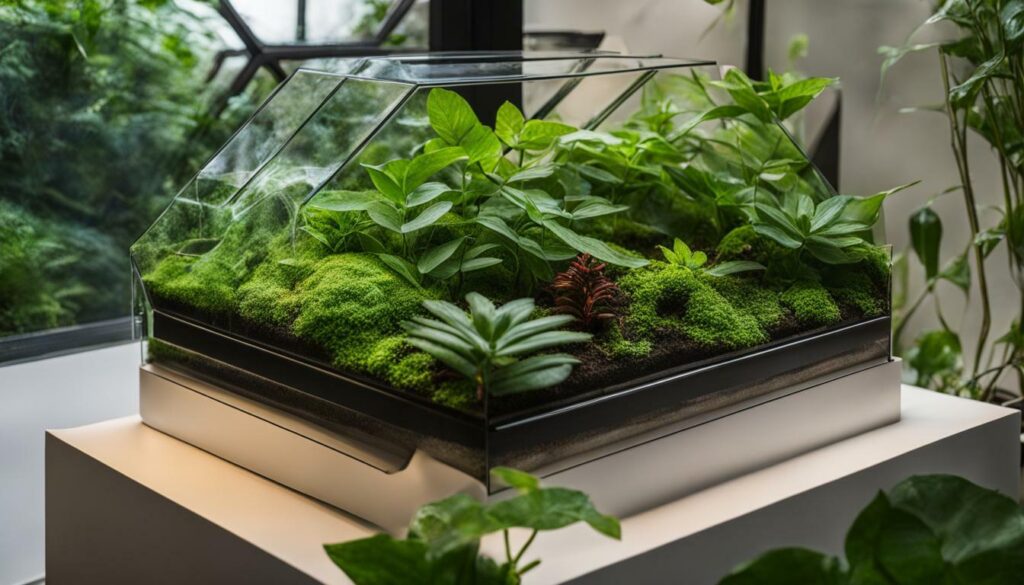
Excess humidity can create a host of problems in terrariums, but with proper ventilation, you can effectively control and manage humidity levels. High humidity can lead to issues like mold, fungi, and bacterial infections, which can harm your plants and compromise the overall health of the terrarium environment. By maintaining proper ventilation in your terrarium, you can ensure that air circulation is adequate, preventing excess moisture buildup.
A simple and effective way to improve ventilation in your terrarium is to provide air holes or vents. These openings allow fresh air to enter and stale air to exit, creating a continuous airflow that helps regulate humidity levels. Additionally, consider using dehumidifiers or fans to enhance air movement within the terrarium. This can help reduce excess moisture and prevent the growth of harmful microorganisms.
| Ventilation Tips: | Benefits: |
|---|---|
| Place vents or air holes in strategic locations to ensure proper airflow | Prevents stagnant air and excess humidity |
| Add dehumidifiers or fans to promote air circulation | Reduces moisture buildup and inhibits the growth of mold, fungi, and bacteria |
| Monitor humidity levels regularly | Allows you to adjust ventilation as needed to maintain ideal conditions |
Proper ventilation is essential for maintaining the health and well-being of your terrarium. It not only helps prevent the growth of mold, fungi, and bacteria but also ensures that humidity levels are within the desired range. By implementing effective ventilation techniques, you can create a thriving environment for your plants and enjoy the beauty of your terrarium for years to come.
Summary:
- Excess humidity in terrariums can lead to mold, fungi, and bacterial infections.
- Proper ventilation is crucial for controlling and managing humidity levels.
- Air holes, vents, dehumidifiers, and fans are effective tools for improving ventilation.
- Regularly monitoring humidity levels helps ensure optimal conditions in the terrarium.
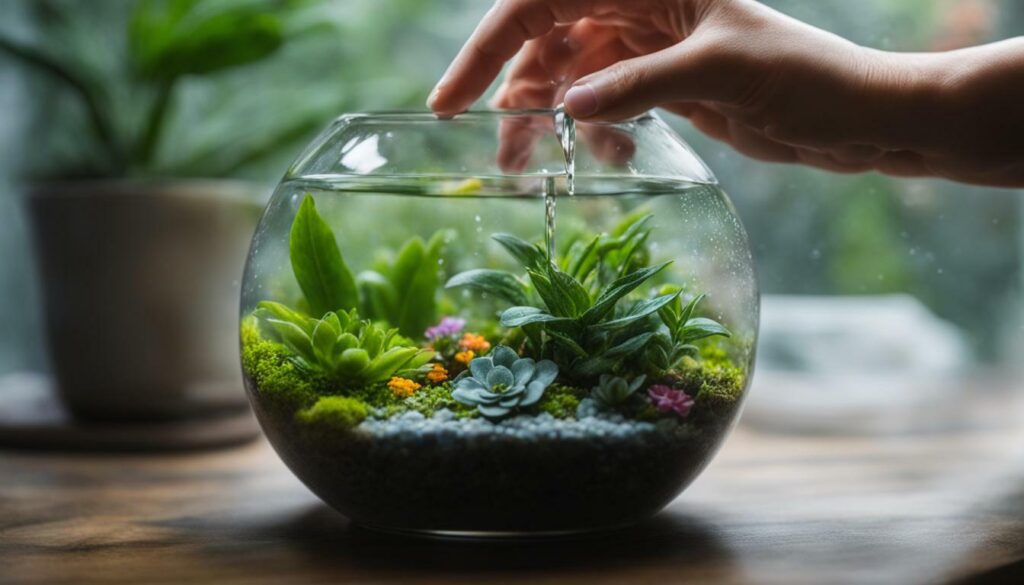
Good drainage is essential for healthy terrariums, and proper ventilation is key to ensuring effective drainage and avoiding water-related issues. Excess water in the soil can lead to problems like wilting, root rot, and the growth of algae or bacteria. To maintain proper drainage, it’s important to pay attention to the terrarium’s ventilation needs and take appropriate measures.
One way to improve drainage is by using well-draining soil. This type of soil allows water to flow through easily, preventing waterlogging. When choosing soil for your terrarium, opt for a mix that includes materials like perlite or sand, which enhance drainage. Additionally, consider amending the soil with these materials if you notice poor drainage in your terrarium.
Regularly checking and maintaining the drainage holes in your terrarium is also crucial. These holes allow excess water to escape, preventing it from accumulating in the bottom of the terrarium. Ensure that the holes are not blocked by debris or soil, as this can impede drainage. If necessary, use a thin stick or toothpick to clear any obstructions.
| Signs of Poor Drainage in a Terrarium | Steps to Ensure Good Drainage |
|---|---|
| Waterlogged soil | Use well-draining soil or amend the soil with perlite or sand |
| Wilting or yellowing plants | Check and clear drainage holes regularly to prevent blockages |
| Persistent presence of water in the terrarium | Adjust watering frequency and amount to avoid overwatering |
| Root rot or fungal growth | Reposition the terrarium to a location with better air circulation |
Another factor to consider is the frequency and amount of watering. Overwatering can lead to poor drainage, so it’s important to find the right balance. Monitor the moisture levels in the soil and adjust your watering habits accordingly. It’s better to underwater than to overwater, as terrarium plants usually thrive in slightly drier conditions.
By ensuring proper ventilation and drainage in your terrarium, you can create a healthy and thriving environment for your plants. Remember to use well-draining soil, check and clear the drainage holes regularly, and adjust your watering habits to maintain the optimal balance of moisture. With these practices in place, you can enjoy a beautiful and flourishing terrarium.
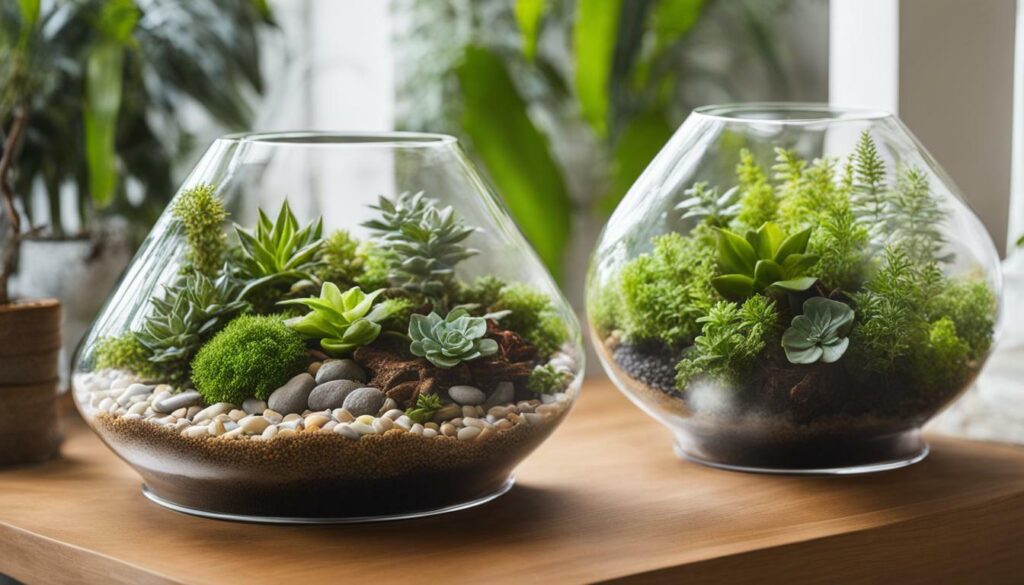
Pests can pose a threat to terrarium health, but with proper ventilation and regular maintenance, you can effectively manage and prevent pest infestations. Be vigilant in maintaining good airflow within your terrarium to discourage pests from taking up residence. Stagnant air, particularly in humid environments, can attract pests like mites and other small insects.
To address pest infestations, start by thoroughly cleaning your terrarium regularly. Remove any decaying plant material or organic debris that could attract pests. Inspect your plants for signs of infestation, such as webs, discoloration, or damage to leaves. If you discover any affected plants or toys, promptly remove them from the terrarium.
In addition to regular cleaning, you can use appropriate pesticides or miticides to treat pest issues. However, be cautious when using such products in an enclosed environment like a terrarium, as some chemicals may harm delicate plants or animals. Always follow the instructions provided by the manufacturer and choose products specifically labeled for use in terrariums.
Remember, prevention is key when it comes to managing pests in terrariums. Beyond ventilation, maintaining air quality is important. Proper airflow will help reduce excess moisture, which can attract pests and lead to mold or bacterial growth. Regularly inspect your terrarium for any signs of pests, and take immediate action to address them to prevent further infestations.
Preventing and Addressing Pests in Terrariums: Key Points
- Proper ventilation and regular maintenance are crucial for effective pest management in terrariums.
- Promote good airflow within the terrarium to discourage pests from taking up residence.
- Clean the terrarium regularly, removing decaying plant material and organic debris that could attract pests.
- Inspect plants for signs of infestation and promptly remove affected plants or toys.
- Use appropriate pesticides or miticides following manufacturer instructions, but exercise caution in an enclosed environment like a terrarium.
- Maintain air quality and reduce excess moisture to prevent pests and mold or bacterial growth.
| Common Pests in Terrariums | Treatment and Prevention |
|---|---|
| Mites | Thoroughly clean the terrarium, remove affected plants or toys, and use appropriate pesticides or miticides. |
| Small Insects | Clean the terrarium regularly, inspect plants for infestation, and remove affected plants or toys. |
| Mold or Fungi | Maintain proper ventilation, reduce excess moisture, and remove any affected areas promptly. |
Pests can be a nuisance in terrariums, but with the right approach, you can keep them under control. Regular maintenance, proper ventilation, and prompt action at the first sign of an infestation are key to a healthy and thriving terrarium.
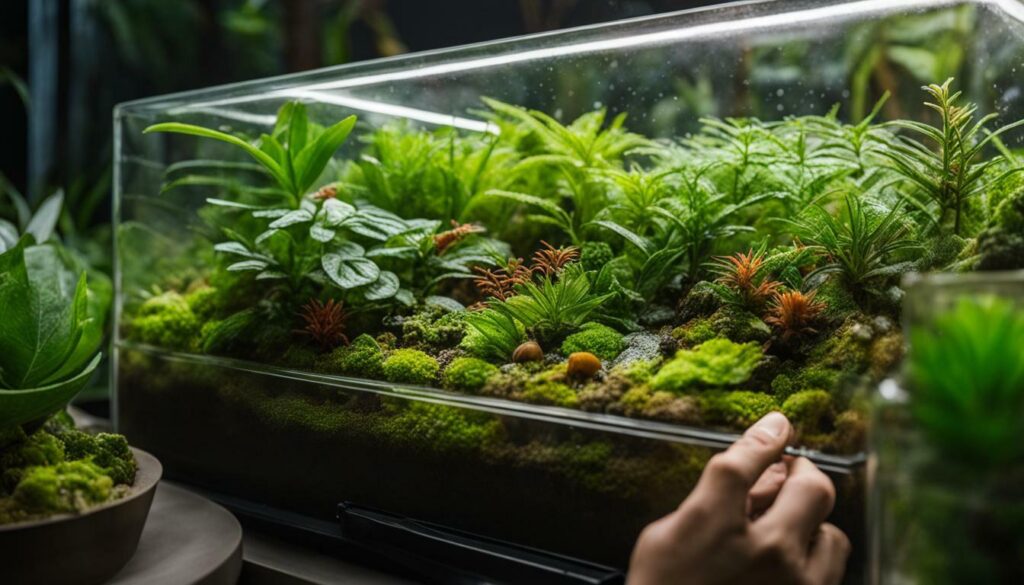
Proper ventilation is crucial for maintaining a healthy and thriving terrarium, and by following the ventilation solutions discussed in this guide, you can ensure optimal conditions for your plants’ growth and well-being.
Mastering terrarium care requires attention to ventilation solutions. Poor air circulation, which can be caused by a small or overcrowded terrarium or a tightly fitted lid without ventilation, can lead to stagnant air and high temperatures, creating ideal conditions for mold and other issues.
To address poor air circulation, ensure that vents and air holes are open and clear. This will allow fresh air to circulate in the terrarium and prevent the buildup of excess moisture and heat. By maintaining clear airflow pathways, you can create a healthy environment for your terrarium plants.
Mold, fungus, and bacteria infections are common problems in terrariums, often caused by uncleaned terrariums or high humidity. Treat these infections by removing affected areas and using hydrogen peroxide or other methods recommended for terrariums. Prevent such infections by keeping the terrarium clean and ensuring proper ventilation.
Algal blooms can occur when there is too much sunlight, warm temperatures, and an abundance of nutrients. Treat algal blooms by removing the affected areas, reducing light exposure, and adding plants that consume excess nutrients. By controlling these factors and ensuring optimal ventilation, you can prevent algal blooms and maintain a balanced ecosystem in your terrarium.
Overheating can occur due to poor ventilation, overcrowding, incorrect lighting, or substrate issues. Address overheating by improving ventilation, pruning overgrown plants to allow for better airflow, and creating shaded areas to reduce direct sunlight exposure. Prevent overheating by ensuring proper ventilation and avoiding direct sunlight and heat sources.
Excess humidity can lead to mold, fungi, and bacterial infections. Reduce humidity by improving air circulation within the terrarium. You can achieve this by opening vents, using dehumidifiers or fans, and avoiding overwatering. By maintaining proper ventilation, you create an environment with balanced humidity levels that will benefit the overall health of your terrarium.
Poor drainage can cause waterlogging, root rot, and nutrient deficiencies. Treat poor drainage by replacing the soil with well-draining material or amending the soil. Prevent poor drainage by using well-draining soil and avoiding overwatering. Excess water in the soil can lead to issues like wilting, root rot, and algae or bacteria growth. Treat excess water by identifying the source and reducing water accumulation. Prevent excess water by checking drainage holes and using proper soil.
Pests, such as mites, can cause damage in terrariums. Treat pests by cleaning the terrarium, removing affected plants or toys, and using appropriate pesticides or miticides. To prevent pests, maintain air quality by ensuring proper ventilation and removing decaying plant material. By incorporating these pest prevention measures, you can keep your terrarium free from infestations and promote a healthy environment for your plants.
Proper ventilation is crucial for maintaining the optimal conditions required for a healthy terrarium. By implementing the ventilation solutions discussed in this guide, you can create an environment that supports the growth and well-being of your terrarium plants. Remember to regularly monitor and adjust the ventilation based on the specific needs of your terrarium to ensure its long-term success.
FAQ
Why is ventilation important in terrariums?
Proper ventilation ensures air circulation, preventing stagnant air and high temperatures that can lead to mold and other issues in terrariums.
How can I improve air circulation in my terrarium?
Make sure vents and air holes are open and clear to allow for proper airflow in the terrarium.
What can I do to prevent mold, fungus, and bacteria infections in my terrarium?
Keep the terrarium clean and ensure proper ventilation to minimize the risk of infections. If infections occur, remove affected areas and use hydrogen peroxide or other treatments.
How can I treat algal blooms in my terrarium?
Remove affected areas, reduce light exposure, and add plants to consume excess nutrients. Proper ventilation also helps prevent algal blooms.
What should I do if my terrarium is overheating?
Improve ventilation, prune overgrown plants, and create shaded areas to address overheating. Prevent overheating by ensuring proper ventilation and avoiding direct sunlight and heat sources.
How can I reduce excess humidity in my terrarium?
Improve air circulation, use dehumidifiers or fans, and keep the terrarium clean to reduce humidity levels and prevent issues like mold and bacterial infections.
What should I do if my terrarium has poor drainage?
Replace the soil with well-draining material or amend the soil to improve drainage. Using well-draining soil and avoiding overwatering also helps prevent poor drainage.
How can I address excess water in my terrarium?
Identify the source of excess water and reduce water accumulation. Issues like wilting, root rot, and algae or bacteria growth can be treated by addressing water-related problems.
How can I manage pests in my terrarium?
Clean the terrarium regularly, remove affected plants or toys, and use appropriate pesticides or miticides to control pests. Maintaining good air quality and removing decaying plant material also helps prevent pest infestations.
What are the benefits of proper ventilation in terrariums?
Proper ventilation helps maintain a healthy environment in the terrarium, preventing issues like mold, high temperatures, poor drainage, and pest infestations.

